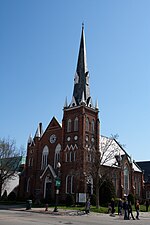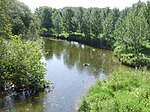Turner Chapel was an African Methodist Episcopalian Church located at 37 Lakeshore Road West in Oakville, Ontario, Canada. It was established in 1890. An earlier structure, built on the east side of Sixteen Mile Creek, had burned down. The west side of the river, where artisans lived, was a more welcoming environment for Oakville's "Black Church". It is telling that the church was named after Bishop Henry McNeal Turner, as he was an advocate of the back-to-Africa movement, and the first black chaplain, appointed by Abraham Lincoln, during the American Civil War.
The escaped slaves were seeking to escape the penalties of the fugitive slave laws which were passed in the United States in the early nineteenth century. Many of the escapees were skilled tradesmen and one of their number developed the technology that made "stoneboating" possible. Stoneboating was a system where ships could grapple for slabs of sedimentary rock which could then be cut and prepared for building materials. The stratification of the rock, a natural process over eons of time, made for regularly shaped "brick-like" material which had the virtue of being easy to form and consistent in shape. In fact, it was an ideal supply for local stonemasons.
It would be an error to think of the newcomers as indigent. Through their intelligence and their craftsmanship they began to have sufficient capital to invest in homes, farms, and a place of worship that was distinctly their own. Rather than copy the places of worship they had known in the southern states they were impressed by the churches of east Oakville. That's likely why they chose red brick for the structure complete with "flying buttresses" which, in essence, are strictly ornamental rather than functional. The floor area of the church is little over 1000 square feet and it was built on sand. This method of building had the virtue of providing complete drainage and keeping the structure free of moisture and the possibility of mold.






